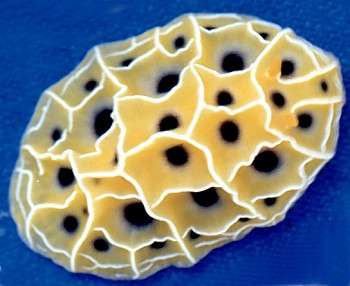
Reticulidia suzanneae
Valdes & Behrens, 2002
Order: NUDIBRANCHIA
Suborder: DORIDINA
Superfamily: EUDORIDOIDEA
Family: Phyllidiidae
DISTRIBUTION
Indian Ocean: East Africa, Thailand.
PHOTO
Surin Island, Thailand. Depth 70-50 feet, 14 November 1999. Photo: Narongpon Sittithaweepat.
Reference:
• Valdes, A. & Behrens, D.W. 2002. Phylogenetic systematics of Reticulidia Brunckhorst, 1990 (Mollusca, Nudibranchia), with the description of a new species from the tropical Indo-Pacific. Nat. Hist. Mus. Los Angeles Co., Contrib. in Sci., 492: 1-10.
Rudman, W.B., 2002 (May 21) Reticulidia suzanneae Valdes & Behrens, 2002. [In] Sea Slug Forum. Australian Museum, Sydney. Available from http://www.seaslugforum.net/find/retisuza
Related messages
Reticulidia suzanneae from Sodwana Bay, S. Africa
October 2, 2009
From: Colin Ogden
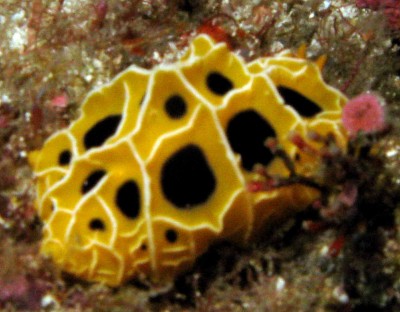
Concerning message #11616:
Hi Bill,
I am attaching a photo taken a month ago of what I believe is a Reticulidia suzanneae which now shows that its range now extends down to Sodwana Bay.
Locality: Sodwana Bay, 40 metres, South Africa, Indian, Aug 2009, deep wall. Length: 50 mm. Photographer: Colin Ogden.
I apologise for the poor quality of the photo, but I am finding that my housing for my camera is distorting at depth and all the buttons get stuck and I can't switch the macro function on.
I thought at first this was a R. halgerda as it was similar to the photo in the latest Gosliner, Behrens, Valdes book, also it was found at 40 meters on an exposed wall facing out to sea. R. suzzaneae according to this book is found in 10 to 25 metres.
Regards
Colin
scubaco@iafrica.com
Ogden, C., 2009 (Oct 2) Reticulidia suzanneae from Sodwana Bay, S. Africa. [Message in] Sea Slug Forum. Australian Museum, Sydney. Available from http://www.seaslugforum.net/find/22677Dear Colin,
This is certainly what has been described as R. suzanneae. Perhaps in time we will find that two species may be just extremes of a colour range. Similarly, it is much too early to be precise about geographic ranges of species and their depth distributions. In many cases we have information for very few specimens of each species. That's why records like yours and other Forum contributors are so important - they are enabling us to flesh out the details on colour variation, geographic distribution, and aspects of a species natural history, which are often sadly missing from new species descriptions.
Best wishes,
Bill Rudman
Re : Reticulidia suzanneae from Mayotte
December 9, 2003
From: Marina Poddubetskaia
Dear Bill,
Thank you very much for so complete an answer about the defensive secretions in phyllidiids. So clear and easily comprehensible information is very valuable for non-scientists like me.
Thank you again for your great help.
Best wishes,
Marina.
nembro@nembro.info
Poddubetskaia, M., 2003 (Dec 9) Re : Reticulidia suzanneae from Mayotte. [Message in] Sea Slug Forum. Australian Museum, Sydney. Available from http://www.seaslugforum.net/find/11627Reticulidia suzanneae from Mayotte
December 6, 2003
From: Marina Poddubetskaia


Dear Bill,
During my collecting mission in Mayotte I saw 2 Reticulidia suzanneae. Each time I touched them to turn them over (for the ventral view photo), they secreted a milky white substance. It can be clearly seen in the ventral view photo [lower photo]. What is it ? I assume it is a toxic secretion and a defensive reaction. What do phyllidiids secrete exactly, toxins or acids? In Phyllidiids the defensive reaction refers to 'allomones', but I don't know what that means. Thank you in advance for filling this gap in my knowledge.
NB. The animal in the middle photo wasn't found on this grey sponge but moved here for photo from an inaccessible place.
Upper Photo: Kongou, Mayotte Island, Indian Ocean, November 15, 2003. Site: Recif de Peitro., Depth: 11m., Size: 40mm. Lower Photos: Handrema, Mayotte Island, Indian Ocean. November 07, 2003. Site: Prevoyante., Depth: 14m., Size: 35mm
Cheers,
Marina.
nembro@nembro.info
Poddubetskaia, M., 2003 (Dec 6) Reticulidia suzanneae from Mayotte. [Message in] Sea Slug Forum. Australian Museum, Sydney. Available from http://www.seaslugforum.net/find/11616
Dear Marina,
Thanks for these photos. I am glad you mentioned you had moved the animal in the middle photo onto that sponge as I was going to include a close-up of the sponge as a possible food. Where possible, it is best if you are re-positioning animals to try and put them somewhere 'neutral' like on a piece of rock. Apart from the problem of adding misleading information, many animals react badly to being put on a sponge or cnidarian colony they are not familiar with and so are difficult to photograph. They may in fact be being stung or affected by defensive secretions being produced by the 'photogenic' colony you have selected.
Concerning defensive secretions in phyllidiids. Most genera produce rather nasty chemicals called sesquiterpene isocyanides. There can be toxic and acidic. I walked into a closed lab one morning where overnight a number of
Concerning what is an allomone. You will have heard of a hormone which is the name we give to chemical substance which an animal uses internally to communicate or send signals to other parts of its body. A whole set of words of been derived from 'hormone' to label other chemical signals.
• pheromone - a chemical substance produced by a species to communicate externally with other members of the same species. [affecting the behaviour or physiology of the same species]
• allomone a chemical substance produced by a species to communicate externally with members of different species. [affecting the behaviour or physiology of another species]
Unfortunately some people feel the need to try and define and name every alternative phenomenon and I am afraid they are at present attempting to narrow the definition of allomone. When it was first proposed its meaning was as I have stated above “a chemical substance released by one species that serves as a communicative
signal to another species”. You should be aware that some people have a much narrower definition:
• allomone Compound produced by one organism that affects, detrimentally, the behaviour of a member of another species.
• kairomone Compound produced by one organism that affects, beneficially, the behaviour of a member of another species, but hurts the animal that produces it.
• synomone Compound produced by one organism that is beneficial to both itself and a member of another species.
Personally I find life becomes unnecessarily complicated when some of out colleagues feel the need to pigeon-hole natural phenomena so minutely.
Best wishes
Bill Rudman
Reticulidia suzanneae from Comoros
June 27, 2002
From: Valeria Safonova
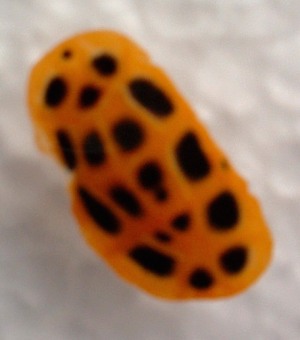
Dear Bill,
Thank you that you answered my message about the Spanish Dancer. I know that the Phyllidia is not your favorite sea slug to identify but I found a sea slug which I thought was a Phyllidia zeylanica but now I doubt. I attach a picture which is not of very good quality.
Regards from Comoros
Valeria
vailulu@hotmail.com
Safonova, V., 2002 (Jun 27) Reticulidia suzanneae from Comoros. [Message in] Sea Slug Forum. Australian Museum, Sydney. Available from http://www.seaslugforum.net/find/7361Dear Valeria,
Thanks for this interesting find. Phyllidiids are not my favourite group to try an identify from photos because we still a lot to learn about them so it is never easy to be sure. However a few of them are quite easy and that includes this one, which has only recently been named. This is Reticulidia suzanneae. Most records are from Thailand, but there is a message on the Forum from Bernard Picton, with a photo of a specimen from Pemba Island, which is not that far up the east African coast from Comoros.
Best wishes,
Bill Rudman
Reticulidia suzanneae from East Africa
May 24, 2002
From: Bernard Picton


Hi Bill,
Here is a photo - and range extension to Pemba Island, East Africa where I spent a week diving in Feb 1999 from the boat Kisiwani.
This is the one you have as Reticulidia sp. 1 - we found several individuals and they looked just like Reticulidia halgerda to me except for the rather more restricted dark colour between the ridges which forms spots rather than filling the area and the paler overall coloration. I have included the R. halgerda photo from Bali, for comparison.
UPPER PHOTO: Indonesia (Bali) - R. halgerda
LOWER PHOTO: Pemba - R. suzanneae
Bernard
bernard.picton.um@nics.gov.uk
Picton, B., 2002 (May 24) Reticulidia suzanneae from East Africa. [Message in] Sea Slug Forum. Australian Museum, Sydney. Available from http://www.seaslugforum.net/find/6470Thanks Bernard,
I have just got a message today informing me that this species is now named Reticulidia suzanneae. Nice to be able to increase its known geographical range so quickly.
Cheers,
Bill Rudman
Reticulidia suzanneae from Thailand
May 24, 2002
From: David Behrens
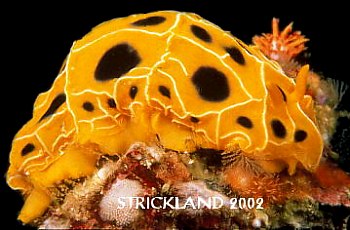
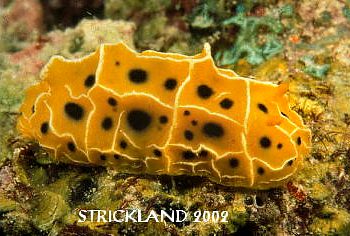
Dear Bill:
Reticulidia sp 1 on the Forum has now been described as Reticulidia suzanneae Valdes & Behrens 2002. The attached photographs of the type specimens were taken by Mark Strickland, at Similan Island, Andaman Sea, Thailand in February, 2001. Specimens measured up to 70mm in length, and were collected on coral rubble bottom at a depth of 21m. This description adds a third species to the genus in the Indo-Pacific and a fourth worldwide.
Reference:
• Valdes, A. & Behrens, D.W. 2002. Phylogenetic systematics of Reticulidia Brunckhorst, 1990 (Mollusca, Nudibranchia), with the description of a new species from the tropical Indo-Pacific. Nat. Hist. Mus. Los Angeles Co., Contrib. in Sci., 492: 1-10.
Dave Behrens
dave@seachallengers.com
Behrens, D., 2002 (May 24) Reticulidia suzanneae from Thailand. [Message in] Sea Slug Forum. Australian Museum, Sydney. Available from http://www.seaslugforum.net/find/7024Thanks for keeping the Forum up to date on new names. I am just posting a message from Bernard Picton today increasing this animal's distribution to the western side of the Indian Ocean.
Cheers,
Bill Rudman
Reticulidia sp? from Thailand
February 2, 2001
From: Erwin Koehler
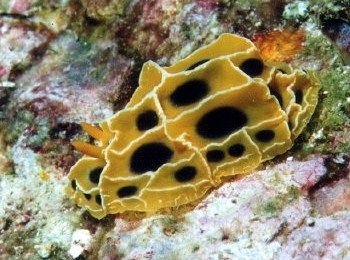
Dear Bill,
Here is the next one from Thailand, Racha Yai Island, divesite "Lucy's Reef", depth 12m, size 44mm, Dec. 20, 2000.
Is it Reticulidia halgerda?
Erwin
Medslugs.Koehler@t-online.de
Koehler, E., 2001 (Feb 2) Reticulidia sp? from Thailand. [Message in] Sea Slug Forum. Australian Museum, Sydney. Available from http://www.seaslugforum.net/find/3660Dear Erwin,
This is an unnamed species, almost certainly a Reticulidia, which has already been reported on the Forum from Thailand as Reticulidia sp. 1
Reticulidia not Halgerda
April 11, 2000
From: Narongpon Sittithaweepat

Dear Bill
Concerning your earlier comments, I think it isn't Halgerda because it has gill between notch and foot. I think it is Reticulidia sp.
Thank you
Narongpon Sittithaweepat.
chromodorid@yahoo.com
Sittithaweepat , N., 2000 (Apr 11) Reticulidia not Halgerda. [Message in] Sea Slug Forum. Australian Museum, Sydney. Available from http://www.seaslugforum.net/find/2246
Dear Narongpon,
You are quite right. If it has the gills underneath the mantle as you describe it is clearly not Halgerda.
Thanks for the second photo. Certainly no sign of a gill pocket. Your animal is an unnamed species of Reticulidia, Reticulidia fungia and Reticulidia halgerda being the only two described species.
For those of you unfamilar with the gills in phyllidiids I have included here a photo showing the secondary gill leaflets of Phyllidia ocellata which, like all phyllidiids, form a band down each side of the body beneath the mantle skirt.
Best wishes,
Bill Rudman.
Halgerda sp. from Thailand
April 10, 2000
From: Narongpon Sittithaweepat
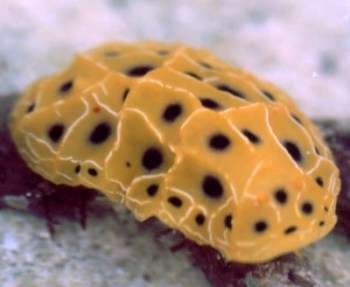
Dear Bill
I can't identify this nudibranch. I found it at Surin Island. I found to depth 70-50 feet and date 14 November 1999. I think it is genus Reticulidia sp.
Thank you
Narongpon Sittithaweepat
chromodorid@thaimail.com
Sittithaweepat. N., 2000 (Apr 10) Halgerda sp. from Thailand. [Message in] Sea Slug Forum. Australian Museum, Sydney. Available from http://www.seaslugforum.net/find/2239Dear Narongpon,
In a photo it's a bit difficult to be sure, but I think this is a species of Halgerda with the gills retracted into the gill pocket, rather than a species of Reticulidia, which like all phyllidiids, would have no dorsal circlet of gills.
If it is a Halgerda I think it is an unnamed species. Not many species have been described with a white line along the mantle ridges.
Halgerda xishaensis Lin, 1975, is brown with white ridges and dark brown 'knobs' or tubercles at the junction of the ridges.
H. dalanghita has a pale whitish line edged in brownish spots, and H. albocristata has secondary white lines radiating out from the tubercles. It also has a white border with black lines at right angles to the mantle edge.
None of these species have large black or dark spots in the 'valleys' as in this animal from Surin Island. It is an interesting find Narongpon. It looks quite similar to Halgerda sp. 4. from Kerama Island, but that animal was probably a juvenile, so it hard to compare them.
Best wishes,
Bill Rudman.
